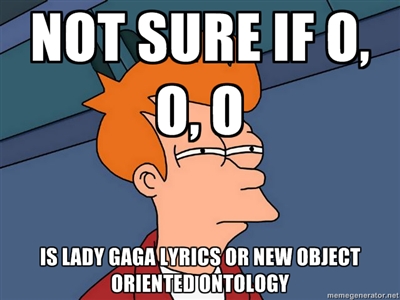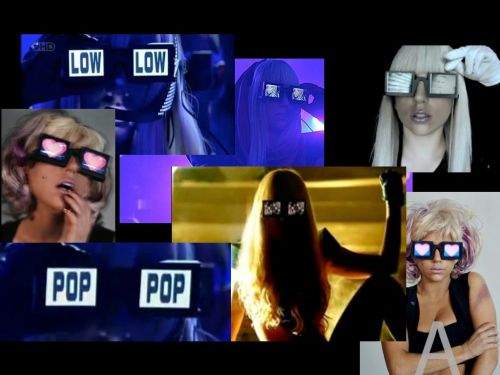À propos of my “Object-Oriented Gaga” talk/video (or not…): I ran across the above image while doing some follow-up research on the topic. Filed under: “weird stuff.”
Tag: Lady Gaga
Object-Oriented Gaga #c21nonhuman
Above is a screencast of my talk, “Object-Oriented Gaga: Theorizing the Nonhuman Mediation of Twenty-First Century Celebrity,” which I am giving right now (that is, simultaneous with this posting, at 2:30 pm US Central Time on May 5, 2012) in the panel “Queer/Feminist/Gaga” at the “Nonhuman Turn” conference at the University of Wisconsin-Milwaukee’s Center for 21st Century Studies.
(For a larger view, click here to go straight to the video on YouTube.)
Nonhuman Turn: Curricular Guide
[scribd id=86447620 key=key-1wkcqyd2d1xtxy5ycwq4 mode=list]
The conference organizers for the upcoming “Nonhuman Turn” conference in Milwaukee (where I’ll be giving a talk called “Object-Oriented Gaga”) have posted a “Curricular Guide,” which includes all the abstracts for the conference. As with the preliminary schedule before, I am embedding it here for convenience.
Nonhuman Turn: Preliminary Schedule
[scribd id=83157625 key=key-kjw30kh28npillit3iq mode=list]
The preliminary schedule for the Nonhuman Turn conference, where I’ll be presenting a paper on Lady Gaga, is now online, as I just learned from Adrian Ivakhiv (who has also just posted the abstract for his talk, “Process-Relational Theory and the Eco-Ontological Turn: Clearing the Ground between Whitehead, Deleuze, and Harman.”) For the sake of convenience, I have taken the liberty of embedding the schedule here.
Object-Oriented Gaga and the Nonhuman Turn
A while back, I posted the CFP for a conference on “The Nonhuman Turn in 21st Century Studies” to be held at the Center for 21st Century Studies at the University of Wisconsin-Milwaukee, May 3-5, 2012 (the original announcement is here). The lineup of invited speakers, in case you haven’t seen it, is very impressive:
Jane Bennett (Political Science, Johns Hopkins)
Ian Bogost (Literature, Communication, Culture, Georgia Tech)
Wendy Chun (Media and Modern Culture, Brown)
Mark Hansen (Literature, Duke)
Erin Manning (Philosophy/Dance, Concordia University, Montreal)
Brian Massumi (Philosophy, University of Montreal)
Tim Morton (English, UC-Davis)
Steven Shaviro (English, Wayne State)
In addition to these speakers, there will also be several breakout sessions at the conference. And, as luck would have it, I will be presenting in one of them, as the paper I proposed on Lady Gaga and the role of nonhuman agency in twenty-first century celebrity has been accepted by the conference organizers! I am honored and excited to have the chance to speak in such distinguished company, and I very much look forward to the conference. In the meantime, here is the abstract for my talk:
Object-Oriented Gaga: Theorizing the Nonhuman Mediation of Twenty-First Century Celebrity
Shane Denson, Leibniz Universität Hannover
In this paper, I wish to explore (from a primarily media-theoretical perspective) how concepts of nonhuman agency and the distribution of human agency across networks of nonhuman objects contribute to, and help illuminate, an ongoing redefinition of celebrity personae in twenty-first century popular culture. As my central case study, I propose looking at Lady Gaga as a “serial figure”—as a persona that, not unlike figures such as Batman, Frankenstein, Dracula, or Tarzan, is serially instantiated across a variety of media, repeatedly restaged and remixed through an interplay of repetition and variation, thus embodying seriality as a plurimedial interface between trajectories of continuity and discontinuity. As with classic serial figures, whose liminal, double, or secret identities broker traffic between disparate—diegetic and extradiegetic, i.e. medial—times and spaces, so too does Lady Gaga articulate together various media (music, video, fashion, social media) and various sociocultural spheres, values, and identifications (mainstream, alternative, kitsch, pop/art, straight, queer). In this sense, Gaga may be seen to follow in the line of Elvis, David Bowie, and Madonna, among others. Setting these stars in relation to iconic fictional characters shaped by their many transitions between literature, film, radio, television, and digital media promises to shed light on the changing medial contours of contemporary popularity—especially when we consider the formal properties that enable serial figures’ longevity and flexibility: above all, their firm iconic grounding in networks of nonhuman objects (capes, masks, fangs, neckbolts, etc.) and their ontological vacillations between the human and the nonhuman (the animal, the technical, or the monstrous). Serial figures define a nexus of seriality and mediality, and by straddling the divide between medial “inside” and “outside” (e.g. between diegesis and framing medium, fiction and the “real world”), they are able to track media transformations over time and offer up images of the interconnected processes of medial and cultural change. This ability is grounded, then, in the inherent “queerness” of serial figures—the queer duplicity of their diegetic identities, of their extra- and intermedial proliferations, and of the networks of objects that define them. Lady Gaga transforms this queerness from a medial condition into an explicit ideology, one which sits uneasily between the mainstream and the exceptional, and she does so on the basis of a network of queer nonhuman objects—disco sticks, disco gloves, iPod LCD glasses, etc.—that alternate between (anthropocentrically defined) functionality and a sheer ornamentality of the object, in the process destabilizing the agency of the individual star and dispersing it amongst a network of nonhuman agencies. As an object-oriented serial figure, I propose, Lady Gaga may be an image of our contemporary convergence culture itself.
Bowie Turns 65: Pop-Star Iconicity and the Serialization of Self
[youtube http://www.youtube.com/watch?v=eBvR08RD_-I]
David Bowie turns 65 today, and among the various birthday tributes and other pieces written for the occasion is this article by David Hudson, appearing in mubi.com’s “The Daily” column: “Bowie @ 65“. Most interesting, to me, is Hudson’s identification of “Bowie’s #1 lesson in staying power: Create a persona and then kill it off with the next one.” Hudson is right, I believe, to single out what amounts to a principle of seriality as the open secret of Bowie’s success — a principle taken up, as Hudson also correctly observes, by Michael Jackson, Madonna, and Prince in the 1980s. As I’ve recently argued, it’s precisely this principle — with Bowie as a direct influence, no less — that Lady Gaga has begun adapting to the changed medial parameters of twenty-first century convergence culture (see here for a summary). I’ll have more to say about this sort of serialized celebrity soon, but for now: Happy birthday to one of the original progenitors of pop stardom qua serial media remix!
Bollywood Gaga
[youtube http://www.youtube.com/watch?v=v8dJicEtrGs]
Apart from superheroes, politics, Photoshop, and video games (see yesterday’s post), two other obsessions interests of this blog over the past several months have been Bollywood and Lady Gaga. There are, of course, reasons for all of these things: my interest in superheroes is related to my work on comics, and they’ve been brought together with American politics (and especially #OWS) in ways that highlight the importance of visual and social media at the current moment, while, at the same time, I’ve been teaching a seminar on game studies this semester. Then there’s our still ongoing Bollywood Nation film series (in which three films have been screened so far, all starring Shah Rukh Khan), and I gave a presentation on Gaga last week at our conference on “Cultural Distinctions Remediated.” Strangely, all of these things are starting to come together: here, Shah Rukh Khan interviews Gaga on Indian television, going so far as to raise the prospect of Gaga acting in a Bollywood movie!
Global Gaga
[youtube http://www.youtube.com/watch?v=IF5WYaoWXI4]
As I’m preparing a talk on Lady Gaga for the upcoming conference “Cultural Distinctions Remediated: Beyond the High, the Low, and the Middle” (to be held here in Hannover December 15-17, 2011), Ruth Mayer just sent me a link to the video above. Wow! What else can you say about that? (Especially if, like me, you don’t understand even a fraction of what’s going on there?) Judging from the looks of it, this certainly seems to be one remediation that’s “beyond the high, the low, and the middle” – where exactly is it, though, and who’s that woman at 3:15-3:20? (By the way, if anyone’s looking for X-mas present ideas, I’ll take one of those cool t-shirts with her face on it being peddled via the youtube video description):
Shane Denson, “Lady Gaga’s Mainstream Queer”
[UPDATE: a revised version of this paper was presented at the “Nonhuman Turn” conference in Milwaukee, May 2012. A screencast video of the complete presentation is available here: Object-Oriented Gaga.]
Abstract for Shane Denson’s talk at “Cultural Distinctions Remediated: Beyond the High, the Low, and the Middle” (Leibniz University of Hannover, 15-17 December 2011):
Lady Gaga’s Mainstream Queer: A Serial Media Remix
Shane Denson (American Studies, Hannover)
In this paper, I propose looking at Lady Gaga as a “serial figure”—as a persona that, not unlike Batman, Frankenstein, Dracula, or Tarzan, is serially instantiated across a variety of media, repeatedly restaged and remixed through an interplay of repetition and variation, thus embodying seriality as a plurimedial interface between trajectories of continuity and discontinuity. As was the case with classic serial figures, whose liminal, double, or secret identities broker traffic between disparate—diegetic and extradiegetic, i.e. medial—times and spaces, so too does Lady Gaga articulate together various media (music, video, fashion, social media) and various sociocultural spheres, values, and identifications (mainstream, alternative, kitsch, pop/art, straight, queer). In this sense, Gaga may be seen to follow in the line of Elvis, David Bowie, and Madonna, among others. Setting these stars in relation to iconic fictional characters shaped by their many transitions between literature, film, radio, television, and digital media promises to shed light on the changing medial contours of contemporary popularity. Serial figures define a nexus of seriality and mediality, and by straddling the divide between medial “inside” and “outside” (e.g. between diegesis and framing medium, fiction and the “real world”), they are able to track media transformations over time and offer up images of the interconnected processes of medial and cultural change. This ability is grounded, then, in the inherent “queerness” of serial figures, which Lady Gaga transforms from a medial condition into an explicit ideology, one which sits uneasily between the mainstream and the exceptional. As a serial figure, I propose, Lady Gaga may be an image of our contemporary convergence culture itself.



